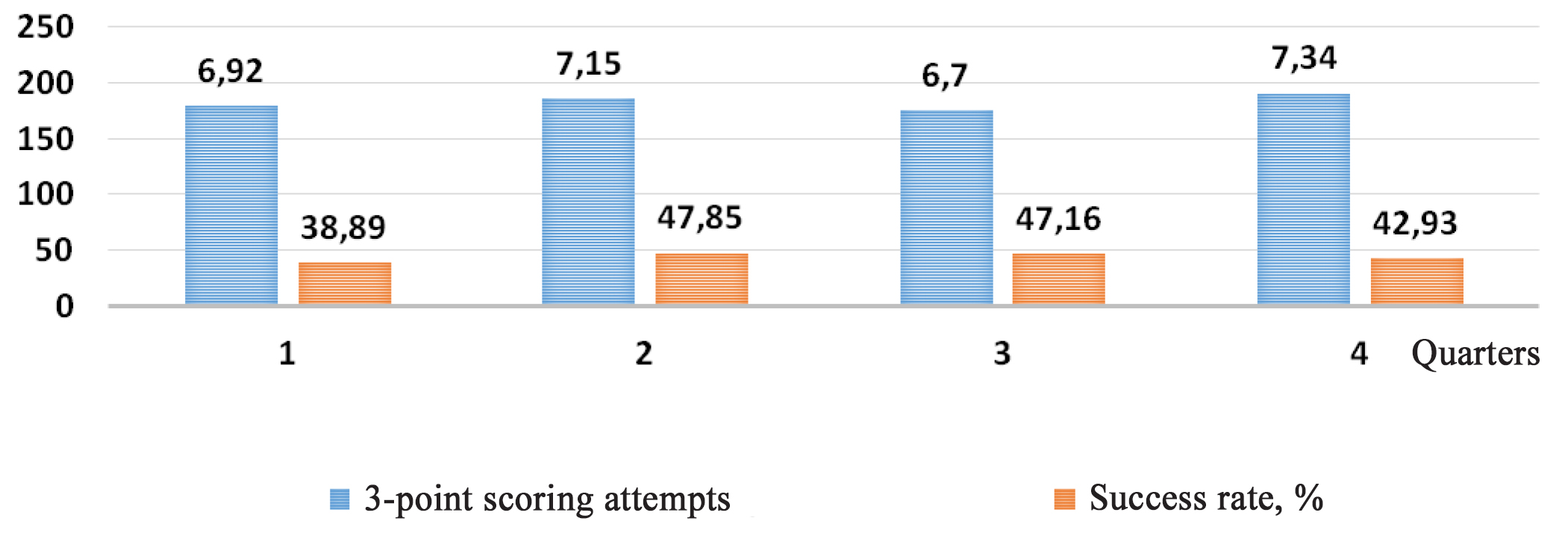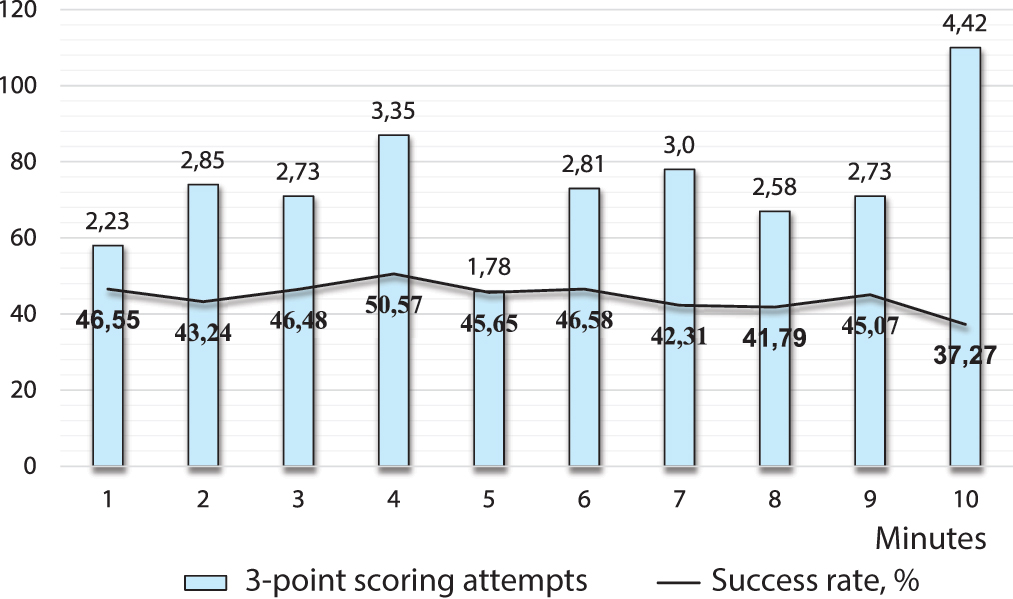Elite female basketball players' competitive three-point scoring analysis
Фотографии:
ˑ:
Dr.Hab., Professor L.B. Andryushchenko1
Dr.Hab., Professor S.V. Chernov1
Master A.A. Markova1
O.N. Andryushchenko2
1Russian State University of Physical Education, Sports, Youth and Tourism (GTSOLIFK), Moscow
2Financial University under the Government of the Russian Federation, Moscow
Keywords: basketball, competitive performance, three-point scorers.
Background. Presently basketball is ranked among the most popular team sports the world over firmly holding a position in the top ten sports both in numbers of fans and players and commercial success rates [1]. The popularity of sport is also confirmed by the fact that the formal membership of the International Basketball Federation (FIBA) totals as many as 214 nations [2]. High priority is being given by the modern Russian and global basketball theory and practices to the three-point scoring success improving methods to further advance the game quality and popularity. The presently available teaching aids, training manuals and practical guidebooks on the matters of scoring skills improvement on the whole and three-point scoring in particular are mostly based on at least 30-years-long practical coaching experiences and, hence, provide little if any guidance in the modern basketball development trends. Therefore, the key problem for the study was to remove the contradiction between the following: on the one hand, objective need for the three-point shooting success being stepped up by the attacking players despite the relatively low success rate of these throws versus the short-, middle-distance and penalty ones; and, on the other hand, poor supply of theoretically grounded practical recommendations on how the success rates may be increased in the competitive performance of the elite national basketball players. This problem was pivotal for the topic of the study, its objective and goals.
Objective of the study was to analyse the competitive three-point shooting statistics of the national top-skilled basketball players.
Methods and structure of the study. Subject to the study was the three-point scoring statistics (735 throws in total) of 10 elite and most successful club scorers playing in the national Premier League as provided by their competitive performance (CP) records of the season of 2015-16. Special emphasis was made on the shooting attempts and shooting success rates in the CP records of the home and guest matches in the regular Russian Championship and playoff matches; in won versus lost games; in game situations classified by intensity as follows: when the team scores are equal; and for the team scores +/-1 to +/-3; +/-4 to +/-5; +/-6 to +/-10; and +/-11 plus different. The above data were averaged on a group-specific basis to arrive to a conclusion on the factors of influence on the scoring success.
Study results and discussion. Analysis of the shooting attempts and shooting success rates in the home and guest matches showed the average shooting success in the home matches being 12.71% higher versus the guest matches; and the shooting attempts in the home matches being 14.39% higher versus the guest matches: see Table 1.
Table 1. Average 3-point shooting success rates of the Premier League female basketball players in the 2015-2016 season in the home versus guest matches
|
Matches |
Shooting success rate, % |
Successful shots |
Shooting attempts |
|
Home matches |
46,97 |
186 |
396 |
|
Guest matches |
41,00 |
139 |
339 |
This phenomenon is often referred to as the “advantage of the home field” explainable by the habitual environment, local support, friendly service staff etc., whilst guest matches are always associated with a variety of extra stressors on the competitive performance on the whole and the three-point scoring success in particular.
Furthermore, the performance data analysis showed the shooting attempts in the regular Russian championship matches being 57.56% higher than in the playoff games: see Table 2.
Table 2. Average 3-point shooting success rates of the Premier League female basketball players in the 2015-2016 season in the regular Russian championship versus playoff matches
|
Matches |
Shooting success rate, % |
Successful shots |
Shooting attempts |
|
Regular championship |
43,99 |
227 |
516 |
|
Playoff games |
44,75 |
98 |
219 |
Analysis of the three-point shooting success rates classified by the won and lost matches showed the three-point shooting success rates being 3.41% higher in the lost matches albeit the data difference was statistically insignificant; with the shooting attempts in the won matches being 68.98% higher than in the lost ones: see Table 3.
Table 3. Average 3-point shooting success rates of the Premier League female basketball players in the 2015-2016 season in the won versus lost matches
|
Matches |
Shooting success rate, % |
Successful shots |
Shooting attempts |
|
Wins |
43,85 |
246 |
561 |
|
Losses |
45,40 |
79 |
174 |
Therefore, the study data and analyses were indicative of the too low shooting attempts being probably one of the reasons for the losses. The trend may also be due to the fact that players are more prone in the losing situations to safer options of attacking actions making 3-point scoring attempts only when the game situation is convenient enough for the player or forces the attempt (e.g. when the attack runs out of 24 seconds). This assumption was the reason for us to analyse the 3-point scoring attempts in the game situations classified by intensity: see Table 4.
Table 4. Three-point scoring attempts in the game situations classified by intensity, average per game
|
|
Game situation intensity |
Three-point scoring |
|||
|
Degree |
Difference in the team scores |
Game situation intensity rate, % |
Shooting success rate, % |
Shooting attempts |
|
|
1. |
High |
0 |
4,35 |
40,63 |
1,23 |
|
2. |
ove average |
±1 to ±3 |
19,18 |
44,68 |
5,42 |
|
3. |
Average |
±4 to ±5 |
9,12 |
43,28 |
2,57 |
|
4. |
Below average |
±6 to ±10 |
19,73 |
44,14 |
5,57 |
|
5. |
Low |
±11 plus |
47,62 |
44,57 |
13,46 |
|
Average |
|
43,46 |
5,65 |
||
The above data demonstrates the playoff games being dominated by the average-, below-average- and low-intensity situations i.e. the relatively comfortable ones. In the highly-tense game situations (with the team scores being equal), the three-point shooting success rate and shooting attempts were found to fall by 6.51% and 78.23%, respectively. Therefore, team coachers are recommended to make a special emphasis on the team attacks being finalised by three-point scoring attempts in uncertain situations (when the team scores are equal) on the one hand; and secure the game being driven by strong-willed, disciplined and balanced players highly effective in scoring, on the other hand. Playoff games were found to provide the least favourable conditions for the necessary qualities being trained in elite female basketball players.
We believe that an efficient competitive performance control system may be viewed as one of the promising ways of the tree-point scorers’ training. In this context, we made the scoring success analysis of the 10 best three-point scorers’ performance, the scores being profiled by the match quarters and minutes.
Considering now the scoring rates per match quarters (see Figure 1), we find the top scorers making on average 1.83 scoring attempts per quarter (7.0 throws on goal per game) that means that the shooting attempts were almost the same in every quarter, with the shooting success rate estimated at 44.21%. It should be noted that first-quarter shooting success rate was found 12.03% lower.

Figure 1. Three-point shooting success rates by match quarters
The shooting success rate variations versus the relatively stable numbers of shots per quarters may be explained by the top scorers being relatively slow in reaching the maximal efficiency, i.e. being in need of special warm-up practices.
Furthermore, we analysed the shooting success rate variations by minutes as presented on Figure 2. The scoring attempts and shooting success rates were found to notably sag on minutes 1, 11, 21 and 31 and 5, 15, 25 and 35, respectively. It may also be pertinent to mention the highly active albeit unsuccessful game on minutes 10, 20, 30 and 40 i.e. by the end of each quarter, with 4.23 shots and 37.27% shooting success rate. The highest 3-poing shooting success rate of 50.57% was recorded on minute 4, with the shooting attempts per minute being the second best.

Figure 2. Three-point shooting success rates of the 2015-16 PL top scorers by minutes
Conclusion. Our analysis of the top three-point scorers of the 2015-16 Premier League championship showed the following:
- For the Premier League team being competitive enough, it should have 3-5 top-skilled three-point scorers (a higher number may be impractical) having the following credentials: sound international competitive experience; high shooting activity rates of 85-100 throws on goal per season (3.27-3.84 throws per game) and high shooting success rates of at least 70.0% in the highly- and above-average-intensity game situations;
-
As recommended by the relevant international competitive fitness and quality standards, we identified the following shooting activity and shooting success levels for the top 3-point scorers in the competitive women basketball:
- High level: shooting activity (shots per season) and shooting success (ratio of successful shots, %) of 85-100;
- Above-average level: shooting activity (shots per season) and shooting success (ratio of successful shots, %) of 70-84;
- Average level: shooting activity (shots per season) and shooting success (ratio of successful shots, %) of 55-69;
- Below-average level: shooting activity (shots per season) and shooting success (ratio of successful shots, %) of 39-54;
- Low level: shooting activity (shots per season) and shooting success (ratio of successful shots, %) of less than 38.
References
- Andreev V.I., Kapilevich L.V., Marchenko N.V. Brosok v pryzhke v basketbole. Biomekhanicheskie osnovy i sovershenstvovanie tekhniki. Ucheb. posobie [Jumper in basketball. Biomechanical basics and excelling technology. Study guide]. Tomsk: Polytechnic University publ., 2009, 144 p.
- Andryushchenko O.N., Averyasov V.V., Averyasova J.O. Organizatsiya uchebno-trenirovochnogo protsessa po basketbolu na osnove interaktivnykh tekhnologiy obucheniya [Organization of basketball learning and training process using interactive learning technologies]. Innovatsionnye tekhnologii v nauke i obrazovanii, 2016, no. 1-1 (5), pp. 101-104.
- Andryushchenko L.B. Spetsialnaya podgotovka yunykh basketbolistok k sorevnovatelnoy deyatelnosti v komandakh vysshey ligi v gruppakh vysshego sportivnogo masterstva. Avtoref. dis. kand. ped. nauk [Special pre-season training of junior basketball players in premier league teams in groups of higher sports excellence. PhD diss. abstract]. Moscow, 1988, 24 p.
- Bigeev A.V. Vyyavlenie osnovnykh statisticheskikh pokazateley, vliyayushchikh na rezultat matchey v basketbole [Identification of key statistical indicators affecting match scores in basketball]. Innovatsionnye sredstva i metody podgotovki v sovremennom basketbole [Innovative means and methods of training in modern basketball]. Moscow, 2011, pp. 17-20.
- Botagariev T.A., Kostikova L.V. O nekotorykh pokazatelyakh, opredelyayushchikh kachestvo igry komandy v basketbole [Some indicators of team's performance in basketball]. Sovershenstvovanie spetsialnoy podgotovki sportsmenov vysokoy kvalifikatsii: sb. nauch. statey [Enhancement of special training process of highly skilled athletes. Col. papers]. Alma-Ata, 1990.
- Bolgov A.N. Tekhnologiya upravleniya sorevnovatelnoy deyatelnostyu igrokov kvalifitsirovannoy basketbolnoy komandy. Dis. kand. ped. nauk [Technology management of competitive activity of skilled basketball team players]. Volgograd, 2013, 157 p.
- Yelevich S.N. Dinamika spetsialnoy podgotovlennosti basketbolistov vysokoy kvalifikatsii v sorevnovatelnom periode godichnogo tsikla. Avtoref. dis. kand. ped. nauk [Dynamics of special fitness of highly skilled basketball players in regular season of the annual cycle. PhD diss. abstract]. Moscow, 2004, 24 p.
- Kolotilshchikova S.V. Programmirovannaya takticheskaya podgotovka zhenskikh basketbolnykh komand. Dis. kand. ped. nauk [Programmed tactical training of women's basketball teams. PhD diss.]. Moscow, 2009.
- Loseva I.V., Averyasova J.O., Andryushchenko O.N. Spetsialnaya podgotovka k sorevnovatelnoy deyatelnosti v basketbole [Special training in competitive basketball]. Mater. I Vseros. nauch.-prakt. konf. s mezhdunar. uchastiem "Nauchno-pedagogicheskie shkoly v sfere sporta i fizicheskogo vospitaniya" [Proc. I Nat. res.-pract. conf. with intern. participation "Scholar pedagogical schools in the field of sports and physical education"]. RGUFKSMiT publ., 2016, pp. 126-129.
- Orlan I.V., Andryushchenko L.B., Andryushchenko O.N., Bolgov A.N. Tekhnologiya upravleniya sorevnovatelnoy deyatelnostyu basketbolnoy komandy [Basketball team's competitive activity management technology]. Moscow: TR-print publ., 2014, 152 p.
- Rodionov A.V. Psikhologicheskie osnovy podgotovki basketbolistov [Psychological basics of training of basketball players]. Kiev: Zdorovye publ., 1989, 134 p.
- Smirnov O.V. Sovershenstvovanie metodiki obucheniya yunykh basketbolistov tekhnicheskim priemam napadeniya v bezopornom polozhenii. Dis. kand. ped. nauk [Improvement of methods of teaching junior basketball players unsupported offensive technique. PhD diss.]. Tomsk, 2002, 133 p.
- Chernov S.V. Innovatsionnye tekhnologii podgotovki professionalnykh sportivnykh komand [Innovative technologies for training professional sports teams]. Moscow: Premier school publ., 2005, p. 182.
Corresponding author: andryushenko-lil@mail.ru
Abstract
Successful three-point scoring skills are indispensable in any team’s arsenal since presently the three-point throws account for at least 30% of the best teams’ shots, with the shooting success rate varying on average at the same 30%. This is the reason for the high priority being given at present to the three-point shooting success improving tools and methods in the modern basketball theory and practices. Objective of the study was to analyse the competitive three-point scoring statistics of the top-skilled basketball players. The following methods were applied in the study: empirical data collection method including competitive performance (CP) profiling by the game time with video recording data being applied; analysis of formal technical game protocols; educational monitoring of players’ CP; scoring metrics i.e. three-point shooting success rates of the top team scorers; and the statistical data processing tools offered by the Microsoft Office Excel 2010.Ink toolkit. Subject to the experiments and analyses under the study were 200 national Premier-League basketball players including 58 best three-point scorers and their CP records as of the season of 2015-16. The study revealed the following results: we identified the factors limiting the competitive three-point scoring success; developed a set of criteria to rate the competitive performance of the three-point scorers; and recommended the coaches to make an emphasis on the three-point scoring attempts with due consideration for the individual conditions and capacities of the team scorers and the game situation tension levels. The study data and analyses made it possible to offer an efficient three-point shooting success improvement method based on a prudent competitive performance management model.



